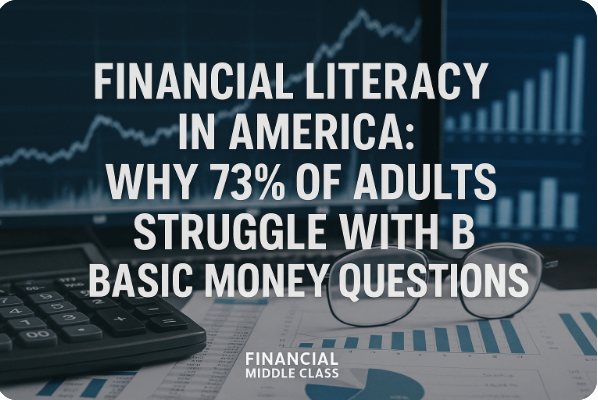Introduction: A National Blind Spot
Every year, surveys reveal an uncomfortable truth: the majority of Americans fail basic financial literacy questions. According to FINRA’s Investor Education Foundation, 73% of U.S. adults cannot correctly answer simple questions on interest, inflation, and risk diversification.
This is not a fringe problem affecting only low-income households. It cuts across the middle class—the same group navigating mortgages, student loans, 401(k)s, credit cards, and health insurance. In a modern economy where individual financial decisions carry greater weight than at any other point in U.S. history, this knowledge gap is a silent crisis.
A Brief History of Financial Literacy in the U.S.
Financial literacy was not always framed as an individual responsibility. For most of the 20th century, the financial landscape was simpler:
- Bank accounts had limited fees.
- Pensions provided retirement security.
- Mortgages were tightly regulated and less complex.
But beginning in the 1970s and accelerating in the 1980s, structural shifts placed more responsibility on individuals:
- The decline of defined-benefit pensions and the rise of 401(k) retirement plans meant workers now had to make complex investment decisions.
- Credit cards became widespread, introducing revolving debt to households.
- Financial deregulation opened the door for more products—often profitable for banks but confusing for consumers.
By the time the 2008 financial crisis hit, the gap between consumer understanding and financial product complexity had widened dangerously.
Where We Stand Today: The Numbers Behind the Crisis
Survey Data
- Only 34% of Americans can correctly answer three simple questions on interest, inflation, and risk diversification.
- Nearly half of adults don’t have enough cash to cover a $400 emergency expense without borrowing or selling something.
- One in five millennials with a retirement account has already taken an early withdrawal, often due to misunderstanding penalties.
Disparities Across Groups
Financial literacy rates vary by age, education, and race/ethnicity:
- Younger adults (18–34): The lowest literacy, despite higher exposure to student debt.
- College graduates: Higher scores, but still fewer than half demonstrate strong literacy.
- Black and Hispanic households: Consistently report lower scores, reflecting disparities in access to resources and historical exclusion from mainstream banking.
Why 73% of Adults Struggle
- Education Gaps
Only about half of states require financial literacy education in high school. Even where required, the quality and depth of instruction vary. Students graduate knowing geometry proofs but not how compound interest works on a student loan.
- Complexity of Financial Products
From teaser-rate credit cards to income-driven repayment plans, even educated consumers face a thicket of jargon and terms designed more for legal compliance than clarity. This “information asymmetry” benefits financial institutions.
- Cultural Silence Around Money
Money talk is taboo. Parents often don’t discuss financial struggles with children, leaving them to “learn the hard way.” Peer-to-peer financial knowledge sharing—critical in many communities—is uneven and often stigmatized.
- Behavioral Economics at Play
Humans are not naturally wired to manage delayed gratification, risk probabilities, or exponential growth (compound interest). Financial institutions, knowingly or not, design products that exploit these weaknesses.
The Real-World Costs of Illiteracy
- Debt Spirals: Households fall prey to high-interest payday loans or misuse credit cards without understanding compounding balances.
- Missed Opportunities: Millions of workers miss out on employer retirement matches simply because they don’t know how to enroll or invest.
- Wealth Gaps: Households without financial literacy are less likely to build assets, perpetuating generational inequality.
- Scams and Fraud: Lower literacy correlates with higher susceptibility to predatory practices and scams (from Zelle fraud to crypto schemes).
This is not merely about “individual responsibility.” It has macroeconomic consequences: lower savings rates, weaker consumer resilience, and more reliance on public safety nets.
What Can Be Done?
Policy Solutions
- Mandated Financial Literacy in Schools
Not just elective courses, but required, standardized instruction in high school curricula.
- Clearer Product Disclosures
Require banks and credit issuers to present terms in plain English—short, standardized, and comparable across products.
- Employer-Based Programs
Encourage businesses to provide financial wellness education alongside retirement benefits.
- Community and Nonprofit Partnerships
Organizations like Operation HOPE and NEFE fill critical gaps. Expanding these partnerships can reach underserved communities.
Individual Solutions
- Audit Your Knowledge
Take a literacy quiz to identify weak spots. Awareness is step one.
- Practice Micro-Learning
Instead of diving into a 300-page finance book, learn in small, focused bursts—budgeting one week, credit scores the next.
- Leverage Free Tools
Apps that track expenses, government resources like AnnualCreditReport.com, and nonprofit programs can build literacy without cost.
- Peer-to-Peer Learning
Talk about money with family, friends, and colleagues. Breaking the taboo creates a shared knowledge culture.
The Literacy Gap and the Middle Class
The middle class is uniquely at risk: too “rich” to qualify for many assistance programs, too “poor” to afford professional financial advisors. They face the brunt of fees, penalties, and interest charges, often without the literacy to navigate alternatives.
Without intervention, this gap will widen. Financial literacy is no longer optional—it’s survival.
Related Reads:
Tailored Call-to-Action
Take ten minutes this week to identify your top financial blind spot. Is it credit scores? Retirement accounts? Debt repayment? Then find one reputable resource to close that gap.
Financial literacy is not about knowing everything—it’s about mastering the basics that protect your family’s future.
